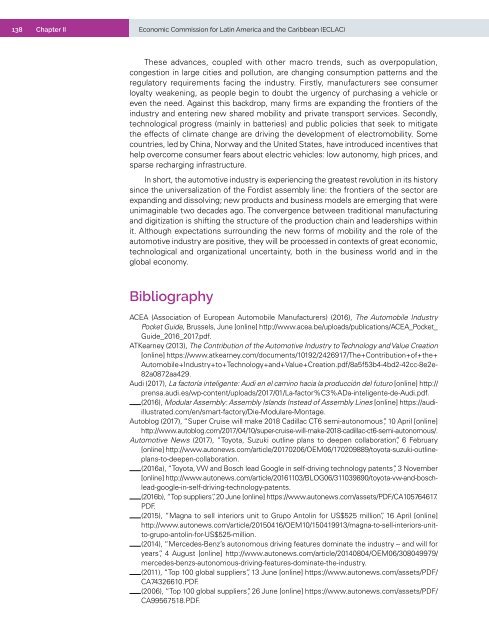Foreign Direct Investment in Latin America and the Caribbean 2017
This publication sets out and analyses the main foreign direct investment (FDI) trends in the countries of Latin America and the Caribbean. The 2017 edition shows that the region is at a difficult juncture. FDI inflows declined by 7.9% in 2016, to US$ 167.043 billion, representing a cumulative fall of 17.0% since the peak in 2011. The fall in commodity prices continues to affect investments in natural resources, sluggish economic growth in several countries has slowed the flow of market-seeking capital, and the global backdrop of technological sophistication and expansion of the digital economy has concentrated transnational investments in developed economies.
This publication sets out and analyses the main foreign direct investment (FDI) trends in the countries of Latin America and the Caribbean. The 2017 edition shows that the region is at a difficult juncture. FDI inflows declined by 7.9% in 2016, to US$ 167.043 billion, representing a cumulative fall of 17.0% since the peak in 2011. The fall in commodity prices continues to affect investments in natural resources, sluggish economic growth in several countries has slowed the flow of market-seeking capital, and the global backdrop of technological sophistication and expansion of the digital economy has concentrated transnational investments in developed economies.
You also want an ePaper? Increase the reach of your titles
YUMPU automatically turns print PDFs into web optimized ePapers that Google loves.
138 Chapter II Economic Commission for Lat<strong>in</strong> <strong>America</strong> <strong>and</strong> <strong>the</strong> <strong>Caribbean</strong> (ECLAC)<br />
These advances, coupled with o<strong>the</strong>r macro trends, such as overpopulation,<br />
congestion <strong>in</strong> large cities <strong>and</strong> pollution, are chang<strong>in</strong>g consumption patterns <strong>and</strong> <strong>the</strong><br />
regulatory requirements fac<strong>in</strong>g <strong>the</strong> <strong>in</strong>dustry. Firstly, manufacturers see consumer<br />
loyalty weaken<strong>in</strong>g, as people beg<strong>in</strong> to doubt <strong>the</strong> urgency of purchas<strong>in</strong>g a vehicle or<br />
even <strong>the</strong> need. Aga<strong>in</strong>st this backdrop, many firms are exp<strong>and</strong><strong>in</strong>g <strong>the</strong> frontiers of <strong>the</strong><br />
<strong>in</strong>dustry <strong>and</strong> enter<strong>in</strong>g new shared mobility <strong>and</strong> private transport services. Secondly,<br />
technological progress (ma<strong>in</strong>ly <strong>in</strong> batteries) <strong>and</strong> public policies that seek to mitigate<br />
<strong>the</strong> effects of climate change are driv<strong>in</strong>g <strong>the</strong> development of electromobility. Some<br />
countries, led by Ch<strong>in</strong>a, Norway <strong>and</strong> <strong>the</strong> United States, have <strong>in</strong>troduced <strong>in</strong>centives that<br />
help overcome consumer fears about electric vehicles: low autonomy, high prices, <strong>and</strong><br />
sparse recharg<strong>in</strong>g <strong>in</strong>frastructure.<br />
In short, <strong>the</strong> automotive <strong>in</strong>dustry is experienc<strong>in</strong>g <strong>the</strong> greatest revolution <strong>in</strong> its history<br />
s<strong>in</strong>ce <strong>the</strong> universalization of <strong>the</strong> Fordist assembly l<strong>in</strong>e: <strong>the</strong> frontiers of <strong>the</strong> sector are<br />
exp<strong>and</strong><strong>in</strong>g <strong>and</strong> dissolv<strong>in</strong>g; new products <strong>and</strong> bus<strong>in</strong>ess models are emerg<strong>in</strong>g that were<br />
unimag<strong>in</strong>able two decades ago. The convergence between traditional manufactur<strong>in</strong>g<br />
<strong>and</strong> digitization is shift<strong>in</strong>g <strong>the</strong> structure of <strong>the</strong> production cha<strong>in</strong> <strong>and</strong> leaderships with<strong>in</strong><br />
it. Although expectations surround<strong>in</strong>g <strong>the</strong> new forms of mobility <strong>and</strong> <strong>the</strong> role of <strong>the</strong><br />
automotive <strong>in</strong>dustry are positive, <strong>the</strong>y will be processed <strong>in</strong> contexts of great economic,<br />
technological <strong>and</strong> organizational uncerta<strong>in</strong>ty, both <strong>in</strong> <strong>the</strong> bus<strong>in</strong>ess world <strong>and</strong> <strong>in</strong> <strong>the</strong><br />
global economy.<br />
Bibliography<br />
ACEA (Association of European Automobile Manufacturers) (2016), The Automobile Industry<br />
Pocket Guide, Brussels, June [onl<strong>in</strong>e] http://www.acea.be/uploads/publications/ACEA_Pocket_<br />
Guide_2016_<strong>2017</strong>.pdf.<br />
ATKearney (2013), The Contribution of <strong>the</strong> Automotive Industry to Technology <strong>and</strong> Value Creation<br />
[onl<strong>in</strong>e] https://www.atkearney.com/documents/10192/2426917/The+Contribution+of+<strong>the</strong>+<br />
Automobile+Industry+to+Technology+<strong>and</strong>+Value+Creation.pdf/8a5f53b4-4bd2-42cc-8e2e-<br />
82a0872aa429.<br />
Audi (<strong>2017</strong>), La factoría <strong>in</strong>teligente: Audi en el cam<strong>in</strong>o hacia la producción del futuro [onl<strong>in</strong>e] http://<br />
prensa.audi.es/wp-content/uploads/<strong>2017</strong>/01/La-factor%C3%ADa-<strong>in</strong>teligente-de-Audi.pdf.<br />
(2016), Modular Assembly: Assembly Isl<strong>and</strong>s Instead of Assembly L<strong>in</strong>es [onl<strong>in</strong>e] https://audiillustrated.com/en/smart-factory/Die-Modulare-Montage.<br />
Autoblog (<strong>2017</strong>), “Super Cruise will make 2018 Cadillac CT6 semi-autonomous”, 10 April [onl<strong>in</strong>e]<br />
http://www.autoblog.com/<strong>2017</strong>/04/10/super-cruise-will-make-2018-cadillac-ct6-semi-autonomous/.<br />
Automotive News (<strong>2017</strong>), “Toyota, Suzuki outl<strong>in</strong>e plans to deepen collaboration”, 6 February<br />
[onl<strong>in</strong>e] http://www.autonews.com/article/<strong>2017</strong>0206/OEM06/170209889/toyota-suzuki-outl<strong>in</strong>eplans-to-deepen-collaboration.<br />
(2016a), “Toyota, VW <strong>and</strong> Bosch lead Google <strong>in</strong> self-driv<strong>in</strong>g technology patents”, 3 November<br />
[onl<strong>in</strong>e] http://www.autonews.com/article/20161103/BLOG06/311039890/toyota-vw-<strong>and</strong>-boschlead-google-<strong>in</strong>-self-driv<strong>in</strong>g-technology-patents.<br />
(2016b), “Top suppliers”, 20 June [onl<strong>in</strong>e] https://www.autonews.com/assets/PDF/CA105764617.<br />
PDF.<br />
(2015), “Magna to sell <strong>in</strong>teriors unit to Grupo Antol<strong>in</strong> for US$525 million”, 16 April [onl<strong>in</strong>e]<br />
http://www.autonews.com/article/20150416/OEM10/150419913/magna-to-sell-<strong>in</strong>teriors-unitto-grupo-antol<strong>in</strong>-for-US$525-million.<br />
(2014), “Mercedes-Benz’s autonomous driv<strong>in</strong>g features dom<strong>in</strong>ate <strong>the</strong> <strong>in</strong>dustry -- <strong>and</strong> will for<br />
years”, 4 August [onl<strong>in</strong>e] http://www.autonews.com/article/20140804/OEM06/308049979/<br />
mercedes-benzs-autonomous-driv<strong>in</strong>g-features-dom<strong>in</strong>ate-<strong>the</strong>-<strong>in</strong>dustry.<br />
(2011), “Top 100 global suppliers”, 13 June [onl<strong>in</strong>e] https://www.autonews.com/assets/PDF/<br />
CA74326610.PDF.<br />
(2006), “Top 100 global suppliers”, 26 June [onl<strong>in</strong>e] https://www.autonews.com/assets/PDF/<br />
CA99567518.PDF.


















